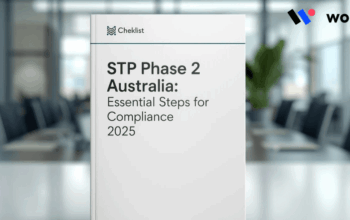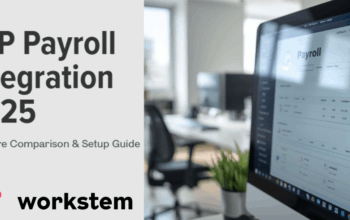Quick Facts: Single Touch Payroll (STP)
- What it is: A mandatory ATO system for reporting payroll information each time you pay employees.
- Who it’s for: All Australian employers with at least one employee.
- STP Phase 2 Deadline: Most employers were required to transition by 1 January 2023. The ATO has granted deferrals to some software providers; ensure you are compliant now.
- 2025 Finalisation Due Date: 14 July 2025 (The annual process of finalising your STP data for the financial year ended 30 June 2025).
Single Touch Payroll (STP) has fundamentally changed how Australian businesses manage their payroll compliance. While it was introduced in 2018, the expanded STP Phase 2 rules are now in full effect. For employers in 2025, understanding these requirements is non-negotiable.
This guide breaks down everything you need to know, from the basics to the intricacies of Phase 2, ensuring your business remains fully compliant.
Complete STP System Overview & Business Impact
Single Touch Payroll is an Australian Taxation Office (ATO) initiative that requires employers to report their employees’ payroll information—such as salaries, wages, pay-as-you-go (PAYG) withholding, and superannuation—each time they are paid.
The Core Concept: Instead of waiting until the end of the financial year to lodge a payment summary annual report, you send this data to the ATO in real-time through STP-enabled software. This streamlines reporting and provides the ATO and Services Australia with more timely and accurate information.
The Business Impact:
- Reduced Admin Burden: Eliminates the need for providing printed payment summaries to employees.
- Increased Accuracy: Real-time reporting reduces the risk of errors accumulating over a full year.
- Improved Transparency: Employees can view their year-to-date tax and super information through myGov at any time.
Real-time Payroll Reporting to the ATO Explained
The process is designed to be seamless when using compliant software like Workstem:
- You run your payroll as you normally would.
- Your STP-enabled software calculates the pay, taxes, and super for each employee.
- When you finalise the pay run, the software securely sends the required data to the ATO.
- The ATO processes this information and makes it available to the employee via their myGov account.
- At the end of the financial year, you “finalise” your STP data, which tells the ATO that no further changes will be made. This acts as the official income statement for your employees.
Who Must Use STP: Employee Thresholds & Exemptions
The 1+ Employee Rule
A common question is: “Is STP mandatory for all employers?”
The answer is yes. Since 1 July 2019, all employers in Australia who have one or more employees must report through STP. This includes:
- Full-time, part-time, and casual employees.
- Seasonal, temporary, and non-resident employees working in Australia.
Exemptions: Are There Any?
Exemptions are extremely rare and are granted on a case-by-case basis by the ATO. They are typically only considered for businesses in areas with significant technological barriers (e.g., no internet connection). For the vast majority of Australian businesses, STP reporting is a mandatory requirement.
Contractors vs. Employees Classification
It is critical to correctly classify your workers. Generally, you do not need to report payments to genuine contractors through STP if they have an Australian Business Number (ABN) and invoice you for their work.
However, if a worker is deemed an employee for tax purposes (e.g., they are paid mainly for their labour, have set hours, and don’t have their own insurance), you must report their payments through STP. The ATO provides tools to help you determine the correct status.
Step-by-Step STP Reporting Process:
- Choose STP-Enabled Software: Select a compliant solution like Workstem.
- Set Up Your Business Details: Enter your ATO-linked details and employee information into the software.
- Run Your Regular Payroll: Enter hours, salaries, and any allowances or deductions.
- Submit the Pay Event: After approving the pay run, submit the data file to the ATO directly from your software with a single click.
- Review and Reconcile: Regularly check that the amounts reported to the ATO match your internal records.
- Finalise Annually (Before 14 July): Once the financial year ends and all pay runs are complete, you must declare your STP data as “Finalised.” This generates your employees’ income statements.
Integration with Existing Payroll Systems & Software Compatibility
The key to hassle-free STP compliance is using software that is approved by the ATO for STP Phase 2. The good news is that most modern cloud-based platforms handle this seamlessly.
STP Phase 1 vs. Phase 2: What Changed?
The transition to Phase 2 was the most significant update to STP since its launch. Here’s a quick comparison:
| Feature | STP Phase 1 | STP Phase 2 |
| Income Reporting | Reported a single gross amount. |
Disaggregates gross (e.g., separates overtime, bonuses, paid leave). |
|
Allowances |
Limited detail required. |
More detailed reporting (e.g., specific types like travel or clothing). |
| Employment Type | Basic employment status. |
More specific codes (e.g., full-time, part-time, casual, etc.). |
| Country Code | Not required. |
Required for foreign residents. |
| Tax File Numbers | Not reported. |
Reported for easier data matching. |
How Workstem Helps Manage STP Obligations?
Ensure your business remains compliant effortlessly. Let Workstem’s automated payroll and integrated STP Phase 2 reporting handle the complexity for you. Explore Workstem’s STP Solution today and ensure peace of mind with every pay run.
Simplify award interpretation and payroll processing with Workstem, the all-in-one workforce management & payroll software designed for every industry.Workstem is an ATO-approved STP Phase 2 solution that simplifies compliance by automating the entire process:
- Built-in Validation: Workstem’s software is designed with the correct STP Phase 2 fields and categories, guiding you to enter data correctly and reducing errors.
- Seamless Integration: As an all-in-one platform, Workstem integrates time & attendance, payroll, and STP reporting. This eliminates manual data entry between systems, ensuring the data you report is accurate and consistent.
- Easy Submissions: Reporting is done with a single click at the end of each pay run, with immediate confirmation from the ATO.
- Simplified Finalisation: The year-end finalisation process is streamlined and can be completed in minutes.
Choose from our Standard or Advanced plan to suit your business needs, and stay Fair Work compliant with confidence.
FAQs About the Single Touch Payroll (STP)
Q1: What is Single Touch Payroll (STP) in simple terms?
A: Single Touch Payroll (STP) is a mandatory Australian government initiative that requires businesses to report their employees’ payroll information—such as salaries, wages, pay-as-you-go (PAYG) withholding, and superannuation—to the Australian Taxation Office (ATO) directly from their payroll software each time they run payroll. It’s “single touch” because the reporting happens with a single action at the same time as you pay your staff.
Q2: Who needs to report through STP?
A: Essentially, all Australian employers must report through STP.If you have even one employee, you are generally required to use STP.
Q3: What is the difference between STP Phase 1 and STP Phase 2?
A: STP Phase 2 expands the reporting requirements introduced in Phase 1. The key difference is the level of detail provided to the ATO.
- STP Phase 1 reported total amounts for key figures like gross earnings and tax withheld.
- STP Phase 2 requires a detailed, disaggregated breakdown of an employee’s income (e.g., separating salary, overtime, allowances, and leave payments).
Q4: What are my ongoing STP reporting obligations?
A: Your main ongoing obligations are:
- Report Each Pay Event: Submit the required data to the ATO on or before every pay day.
- Year-End Finalisation: Finalise your data by 14 July each year. This declares the information for the financial year is complete and correct. This replaces the need to provide payment summaries to your employees.
- Keep Records Accurate: Ensure employee details in your payroll software are always up-to-date (e.g., tax declarations, super fund choice).
Q5: I missed the STP Phase 2 migration deadline. What should I do?
A: You should take action immediately:
- Contact your software provider to start the transition process.
- Lodge a voluntary disclosure with the ATO to explain the delay. The ATO generally looks favorably upon businesses that come forward voluntarily and may provide you with a compliance plan or extra time to transition.
- Ensure you are using an ATO-approved STP Phase 2 solution, like Workstem, to become compliant.
Q6: How does STP help with my employees’ Superannuation?
A: While STP itself does not pay your super, it reports the liability for superannuation to the ATO each payday. This allows the ATO to better monitor and ensure that employers are meeting their super guarantee obligations on time. You still need to pay your super contributions to your employees’ funds by the quarterly due dates.
Q7: Does STP change when I have to pay my tax and super?
A: No. STP is a reporting system, not a payment system. The due dates for paying the PAYG withholding tax you report to the ATO and your super guarantee contributions to funds remain unchanged.
Q8: What happens if I make a mistake in my STP report?
A: Mistakes can be fixed. If you discover an error in a past submission, you can make a STP amendment through your payroll software. You simply correct the information in your system and submit a revised update to the ATO. It’s important to correct errors as soon as you find
Q9: Where can I find official information from the ATO?
A9: The best source of truth is always the official ATO website. You can find comprehensive guides, news, and resources on their Single Touch Payroll for employers page.
Book a free demo with our payroll experts and experience how Workstem can streamline your payroll and workforce operations.
Read More:
STP Phase 2 Australia: Post-Migration Compliance Guide & Requirements
Guide to Single Touch Payroll for Closely Held Payees








